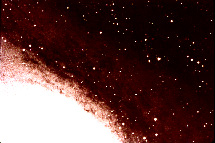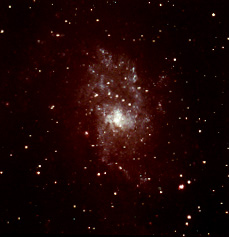The Local Group of Galaxies
First, let's study what is called the "local group" of galaxies. The
largest member of the local group is our Milky Way galaxy. It is orbited by
two irregular satellite galaxies called the Large and Small Magellanic
Clouds. Here's a photograph of the Large Magellanic Cloud.
 Unfortunately for those of us in the northern hemisphere, these
objects are only easily visible from southern latitudes. The Large
Magellanic Cloud is about 160,000 light years away and the Small Magellanic
Cloud is about 210,000 light years away. Therefore this light left when
our ancestors were still competing with the Neanderthals. However, these
galaxies are right on our doorstep. Let's look deeper into space and see
what lies next door.
Unfortunately for those of us in the northern hemisphere, these
objects are only easily visible from southern latitudes. The Large
Magellanic Cloud is about 160,000 light years away and the Small Magellanic
Cloud is about 210,000 light years away. Therefore this light left when
our ancestors were still competing with the Neanderthals. However, these
galaxies are right on our doorstep. Let's look deeper into space and see
what lies next door.
Our local group consists of over 20 galaxies and is dominated by three
large spiral galaxies. First, of course, is the Milky Way. About 2.2
million light years away is the famous Andromeda Galaxy (M31/NGC 224).
This object
is visible in the February evening sky. [Point out Great Square of
Pegusus.] These four stars form the
"Square of Pegusus." If we look a bit north of this square, we see this
fuzzy object (our image here in the planetarium is a good deal more obvious
to the naked eye than the actual nebula in the sky). On a clear dark
night, this object is visible to the naked eye. It's impressive to gaze
upon this object and think that the light entering your eyes left its
source before our species had even evolved. However, our
Australopethicene ancestors were roaming the plains of eastern Africa at
that time!
Here's a photo of the Andromeda Galaxy.
 This photo is a
bit misleading in that the galaxy appears to be surrounded by stars.
Actually, all these stars lie in the foreground, are within the Milky
Way galaxy and lie at most a few thousand light years from us. If we could
rise up out of the Milky Way and take a photograph of the Andromeda Galaxy,
we would see this fuzzy oval floating in black space. Here's a more
detailed photograph.
This photo is a
bit misleading in that the galaxy appears to be surrounded by stars.
Actually, all these stars lie in the foreground, are within the Milky
Way galaxy and lie at most a few thousand light years from us. If we could
rise up out of the Milky Way and take a photograph of the Andromeda Galaxy,
we would see this fuzzy oval floating in black space. Here's a more
detailed photograph.
 In fact, the
Andromeda Galaxy is very similar in size and shape to our own Milky Way
galaxy. We see the disk of the Andromeda Galaxy tilted about 15 degrees
from our line of sight. An interesting coincidence is the fact that the
Milky Way would appear tilted by about the same amount if viewed from the
Andromeda Galaxy. This gives us a good idea of what our own galaxy would
look like if viewed from the outside. Just
as the Large and Small Magellanic Clouds are satellites of the Milky Way,
the Andromeda Galaxy has four small elliptical satellite galaxies. The two
satellites closest to the Andromeda Galaxy are visible in this photograph.
The brightest is M32 (NGC 221) which is quite close to the nucleus of the Andromeda
Galaxy. The other is NGC 205 located here. Both of these galaxies are
visible through a small telescope, but are not visible to the naked eye.
Photographs through large telescopes
even reveal a halo of globular clusters around the Andromeda Galaxy.
Here's a detailed photograph of the Andromeda Galaxy which shows some of
the dust lanes.
In fact, the
Andromeda Galaxy is very similar in size and shape to our own Milky Way
galaxy. We see the disk of the Andromeda Galaxy tilted about 15 degrees
from our line of sight. An interesting coincidence is the fact that the
Milky Way would appear tilted by about the same amount if viewed from the
Andromeda Galaxy. This gives us a good idea of what our own galaxy would
look like if viewed from the outside. Just
as the Large and Small Magellanic Clouds are satellites of the Milky Way,
the Andromeda Galaxy has four small elliptical satellite galaxies. The two
satellites closest to the Andromeda Galaxy are visible in this photograph.
The brightest is M32 (NGC 221) which is quite close to the nucleus of the Andromeda
Galaxy. The other is NGC 205 located here. Both of these galaxies are
visible through a small telescope, but are not visible to the naked eye.
Photographs through large telescopes
even reveal a halo of globular clusters around the Andromeda Galaxy.
Here's a detailed photograph of the Andromeda Galaxy which shows some of
the dust lanes.

The third large galaxy in our local group is the "Pinwheel Galaxy" (M33/NGC
598) in Triangulum. It is located in this area of the sky. [Point
out Triangulum.] Unlike the Andromeda Galaxy, the Pinwheel Galaxy is a
face-on spiral galaxy. This allows us to easily see the spiral structure.
Here's a photo.
 [Point out spiral arms.]
This galaxy lies about 2.4 million
light years from us. It is smaller than both the Andromeda and the Milky
Way and has an estimated diameter of around 40,000 light years. The
Pinwheel Galaxy is not visible to the naked eye and isn't even very easy to see
through small telescopes (although I did see it 3 or 4 months ago at an
open house at the ETSU Observatory). The Pinwheel Galaxy and the Andromeda
Galaxy are only about 570,000 light years apart. As we will discuss
briefly, most of the galaxies in the universe are flying apart. However,
the Milky Way, Andromeda Galaxy, and Pinwheel Galaxy as well as the smaller
members of our local group are gravitationally bound and are not flying
apart.
[Point out spiral arms.]
This galaxy lies about 2.4 million
light years from us. It is smaller than both the Andromeda and the Milky
Way and has an estimated diameter of around 40,000 light years. The
Pinwheel Galaxy is not visible to the naked eye and isn't even very easy to see
through small telescopes (although I did see it 3 or 4 months ago at an
open house at the ETSU Observatory). The Pinwheel Galaxy and the Andromeda
Galaxy are only about 570,000 light years apart. As we will discuss
briefly, most of the galaxies in the universe are flying apart. However,
the Milky Way, Andromeda Galaxy, and Pinwheel Galaxy as well as the smaller
members of our local group are gravitationally bound and are not flying
apart.
Go to next section.
Return to
"Planetarium Shows This Semester"





